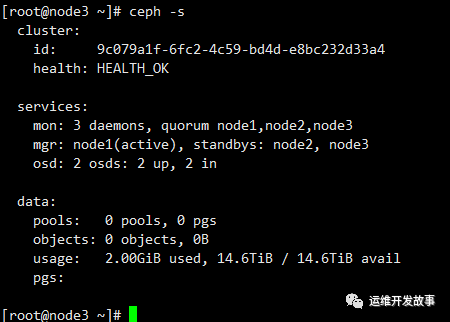关于中兴新支点系统
中兴新支点操作系统基于Linux稳定内核,分为嵌入式操作系统(NewStart CGEL)、服务器操作系统(NewStart CGSL)、桌面操作系统(NewStart NSDL),经过近10年专业研发团队的积累和发展,产品形成安全加固、自主可控、易用管理的突出优势。目前,中兴新支点操作系统已在国内外各大电信运营商、国有大中型企业及电子政务解决方案中投入使用,服务于交换网络、核心网络、骨干网络、智慧城市、视频监控等系统底层。 以上转自某乎。
背景
在国家数字化转型和国产化替代的大背景下,尤其是政务类项目,现在基本用国产化的CPU和操作系统来承载其业务,实现自主创新和安全可靠。 本文在中兴新支点系统(CGSL)和海光CPU上进行ceph离线部署。下面方法也适用于龙蜥和centos8。
制作离线安装包
首先需要找一台可以联网的中兴新支点机器,在上面制作ceph的离线rpm源。中兴新支点系统会默认安装一些组件(如libvirt、qemu),为避免安装ceph时与其他包产生依赖冲突问题,安装系统的时候可以选择最小安装。项目中其他需要安装的组件后面一起安装。我这边除了ceph,libvirt的包也会用到,系统默认安装libvirt的版本较低,我这里都采用手动方式部署并制作离线的rpm包。
yum源配置
中兴新支点系统目前没发现有官方的在线yum源地址。在线安装可以使用龙蜥和epel8的yum源。 下面是yum源的配置。
AnolisOS.repo
[AppStream]
name=AnolisOS-8.6 - AppStream
baseurl=http://mirrors.openanolis.cn/anolis/8.6/AppStream/x86_64/os
enabled=1
gpgcheck=0
gpgkey=file:///etc/pki/rpm-gpg/RPM-GPG-KEY-CGSL-V6
[BaseOS]
name=AnolisOS-8.6 - BaseOS
baseurl=http://mirrors.openanolis.cn/anolis/8.6/BaseOS/x86_64/os
enabled=1
gpgcheck=0
gpgkey=file:///etc/pki/rpm-gpg/RPM-GPG-KEY-CGSL-V6
[DDE]
name=AnolisOS-8.6 - DDE
baseurl=http://mirrors.openanolis.cn/anolis/8.6/DDE/x86_64/os
enabled=1
gpgcheck=0
gpgkey=file:///etc/pki/rpm-gpg/RPM-GPG-KEY-CGSL-V6
[AppStream-debuginfo]
name=AnolisOS-8.6 - AppStream Debuginfo
baseurl=http://mirrors.openanolis.cn/anolis/8.6/AppStream/x86_64/debug
enabled=1
gpgcheck=0
gpgkey=file:///etc/pki/rpm-gpg/RPM-GPG-KEY-CGSL-V6
[BaseOS-debuginfo]
name=AnolisOS-8.6 - BaseOS Debuginfo
baseurl=http://mirrors.openanolis.cn/anolis/8.6/BaseOS/x86_64/debug
enabled=1
gpgcheck=0
gpgkey=file:///etc/pki/rpm-gpg/RPM-GPG-KEY-CGSL-V6
[Plus-debuginfo]
name=AnolisOS-8.6 - Plus Debuginfo
baseurl=http://mirrors.openanolis.cn/anolis/8.6/Plus/x86_64/debug
enabled=1
gpgcheck=0
gpgkey=file:///etc/pki/rpm-gpg/RPM-GPG-KEY-CGSL-V6
[PowerTools-debuginfo]
name=AnolisOS-8.6 - PowerTools Debuginfo
baseurl=http://mirrors.openanolis.cn/anolis/8.6/PowerTools/x86_64/debug
enabled=1
gpgcheck=0
gpgkey=file:///etc/pki/rpm-gpg/RPM-GPG-KEY-CGSL-V6
[DDE-debuginfo]
name=AnolisOS-8.6 - DDE Debuginfo
baseurl=http://mirrors.openanolis.cn/anolis/8.6/DDE/x86_64/debug
enabled=1
gpgcheck=0
gpgkey=file:///etc/pki/rpm-gpg/RPM-GPG-KEY-CGSL-V6
[Extras]
name=AnolisOS-8.6 - Extras
baseurl=http://mirrors.openanolis.cn/anolis/8.6/Extras/x86_64/os
enabled=1
gpgcheck=0
gpgkey=file:///etc/pki/rpm-gpg/RPM-GPG-KEY-CGSL-V6
[HighAvailability]
name=AnolisOS-8.6 - HighAvailability
baseurl=http://mirrors.openanolis.cn/anolis/8.6/HighAvailability/x86_64/os
enabled=1
gpgcheck=0
gpgkey=file:///etc/pki/rpm-gpg/RPM-GPG-KEY-CGSL-V6
[Plus]
name=AnolisOS-8.6 - Plus
baseurl=http://mirrors.openanolis.cn/anolis/8.6/Plus/x86_64/os
enabled=1
gpgcheck=0
gpgkey=file:///etc/pki/rpm-gpg/RPM-GPG-KEY-CGSL-V6
[PowerTools]
name=AnolisOS-8.6 - PowerTools
baseurl=http://mirrors.openanolis.cn/anolis/8.6/PowerTools/x86_64/os
enabled=1
gpgcheck=0
gpgkey=file:///etc/pki/rpm-gpg/RPM-GPG-KEY-CGSL-V6epel.repo
[epel]
name=Extra Packages for Enterprise Linux 8 - $basearch
# It is much more secure to use the metalink, but if you wish to use a local mirror
# place its address here.
baseurl=https://mirrors.aliyun.com/epel/8/Everything/$basearch
metalink=https://mirrors.fedoraproject.org/metalink?repo=epel-8&arch=$basearch&infra=$infra&content=$contentdir
enabled=1
gpgcheck=1
countme=1
gpgkey=file:///etc/yum.repos.d/RPM-GPG-KEY-EPEL-8ceph.repo
[Ceph]
name=Ceph packages for $basearch
baseurl=http://download.ceph.com/rpm-pacific/el8/$basearch
enabled=1
gpgcheck=0
type=rpm-md
gpgkey=https://download.ceph.com/keys/release.asc
[Ceph-noarch]
name=Ceph noarch packages
baseurl=http://download.ceph.com/rpm-pacific/el8/noarch
enabled=1
gpgcheck=0
type=rpm-md
gpgkey=https://download.ceph.com/keys/release.asc
[ceph-source]
name=Ceph source packages
baseurl=http://download.ceph.com/rpm-pacific/el8/SRPMS
enabled=1
gpgcheck=0
type=rpm-md
gpgkey=https://download.ceph.com/keys/release.asc配置yum缓存
[main]
gpgcheck=1
installonly_limit=3
clean_requirements_on_remove=True
best=True
skip_if_unavailable=False
cachedir=/data/yum
keepcache=1安装ceph
yum install ceph -y制作离线仓库
find /data/cache -name "*.rpm" -exec cp {} /mnt \;
createrepo /mnt
tar -zcvf offline.tar.gz mnt/安装ceph
使用做的离线rpm包安装ceph
tar -zxvf offline.tar.gz
cd mnt
rpm -ivh *.rpm --nodeps --force部署monitor节点
所有 Ceph 群集至少需要一个monitor,并且至少需要与存储在群集上的对象副本一样多的 OSD。引导初始mon是部署 Ceph 存储群集的第一步,这里我直接在node1、node2、node3创建三个mon。
在node1添加monitor
为集群生成唯一的fsid,fsid是群集的唯一标识符,代表 Ceph 存储群集主要用于 Ceph 文件系统的文件系统 ID
uuidgen创建ceph配置文件,将生成的fsid添加到配置文件中
vim /etc/ceph/ceph.conf
[global]
fsid=9c079a1f-6fc2-4c59-bd4d-e8bc232d33a4
mon initial members = node1
mon host = 192.168.2.16
public network = 192.168.2.0/24
auth cluster required = cephx
auth service required = cephx
auth client required = cephx
osd journal size = 1024
osd pool default size = 3
osd pool default min size = 2
osd pool default pg num = 8
osd pool default pgp num = 8
osd crush chooseleaf type = 1为群集创建keyring并生成monitor keyring。monitor通过密钥相互通信。必须生成具有monitor密钥的keyring,并在引导初始monitor时提供keyring。
ceph-authtool --create-keyring /tmp/ceph.mon.keyring --gen-key -n mon. --cap mon 'allow *'生成管理员keyring,生成用户并将用户添加到client.admin keyring中。要使用 CLI 工具,必须有一个用户,并且还必须将用户添加到monitor keyring。
ceph-authtool --create-keyring /etc/ceph/ceph.client.admin.keyring --gen-key -n client.admin --cap mon 'allow *' --cap osd 'allow *' --cap mds 'allow *' --cap mgr 'allow *'生成引导 osd 密钥,生成用户并将用户添加到client.bootstrap-osd keyring中。
ceph-authtool --create-keyring /var/lib/ceph/bootstrap-osd/ceph.keyring --gen-key -n client.bootstrap-osd --cap mon 'profile bootstrap-osd' --cap mgr 'allow r'将生成的键添加到 ceph.mon.keyring
ceph-authtool /tmp/ceph.mon.keyring --import-keyring /etc/ceph/ceph.client.admin.keyring
ceph-authtool /tmp/ceph.mon.keyring --import-keyring /var/lib/ceph/bootstrap-osd/ceph.keyring更改 ceph.mon.keyring的所有者。
chown ceph:ceph /tmp/ceph.mon.keyring使用主机名、主机 IP 地址和 FSID 生成monitor映射。将其保存为 :/tmp/monmap
monmaptool --create --add `hostname` 192.168.2.16 --fsid 9c079a1f-6fc2-4c59-bd4d-e8bc232d33a4 /tmp/monmap在monitor主机上创建默认数据目录,目录名是{cluster-name}-{hostname}格式
sudo -u ceph mkdir /var/lib/ceph/mon/ceph-`hostname`在node1节点对monitor进行初始化
sudo -u ceph ceph-mon --mkfs -i `hostname` --monmap /tmp/monmap --keyring /tmp/ceph.mon.keyring启动mon
systemctl start ceph-mon@`hostname` && systemctl enable ceph-mon@`hostname`在另外两个节点安装mon
将密钥和配置文件拷贝至其他节点
scp /tmp/ceph.mon.keyring ceph2:/tmp/ceph.mon.keyring
scp /etc/ceph/* root@ceph2:/etc/ceph/
scp /var/lib/ceph/bootstrap-osd/ceph.keyring root@ceph2:/var/lib/ceph/bootstrap-osd/
scp /tmp/ceph.mon.keyring ceph3:/tmp/ceph.mon.keyring
scp /etc/ceph/* root@ceph3:/etc/ceph/
scp /var/lib/ceph/bootstrap-osd/ceph.keyring root@ceph3:/var/lib/ceph/bootstrap-osd/在两个节点上修改ceph.mon.keyring属主和属组为ceph
chown ceph.ceph /tmp/ceph.mon.keyring获取monmap信息
ceph mon getmap -o /tmp/ceph.mon.map
got monmap epoch 1在mon节点上进行mon初始化
sudo -u ceph ceph-mon --mkfs -i `hostname` --monmap /tmp/ceph.mon.map --keyring /tmp/ceph.mon.keyring
sudo -u ceph ceph-mon --mkfs -i `hostname` --monmap /tmp/ceph.mon.map --keyring /tmp/ceph.mon.keyring在两个节点上启动mon
systemctl start ceph-mon@`hostname` && systemctl enable ceph-mon@`hostname`修改ceph.conf并重启ceph-mon(所有节点操作)
vim /etc/ceph/ceph.conf
mon initial members = node1,node2,node3
mon host = 192.168.2.16,192.168.2.17,192.168.2.18
systemctl restart ceph-mon@`hostname`移除mon
ceph mon remove {mon-id}添加osd
Ceph提供了该ceph-volume实用程序,该实用程序可以准备逻辑卷,磁盘或分区以供Ceph使用。该ceph-volume实用程序通过增加索引来创建OSD ID。
创建osd
在node1执行
ceph-volume lvm create --data /dev/sdb上面的创建过程可以分为两个阶段(准备和激活):
ceph-volume lvm prepare --data /dev/sdb
查看osd fsid
ceph-volume lvm list
ceph-volume lvm activate {ID} {FSID}启动各个节点osd进程
#node1
systemctl restart ceph-osd@0
systemctl enable ceph-osd@0
#node2
systemctl restart ceph-osd@1
systemctl enable ceph-osd@1
#node3
systemctl restart ceph-osd@2
systemctl enable ceph-osd@2创建MGR
在运行ceph-mon守护程序的每个节点上,还应该设置一个ceph-mgr守护程序。
创建密钥目录
所有mgr节点都要执行
sudo -u ceph mkdir /var/lib/ceph/mgr/ceph-`hostname -s`
cd /var/lib/ceph/mgr/ceph-`hostname -s`创建身份验证密钥
ceph auth get-or-create mgr.`hostname -s` mon 'allow profile mgr' osd 'allow *' mds 'allow *' > keyring
chown ceph.ceph /var/lib/ceph/mgr/ceph-`hostname`/keyring启动mgr守护进程
systemctl enable ceph-mgr@`hostname -s` && systemctl start ceph-mgr@`hostname -s`
或者
ceph-mgr -i `hostname`最后查看ceph运行状态,我只添加了两个osd



































